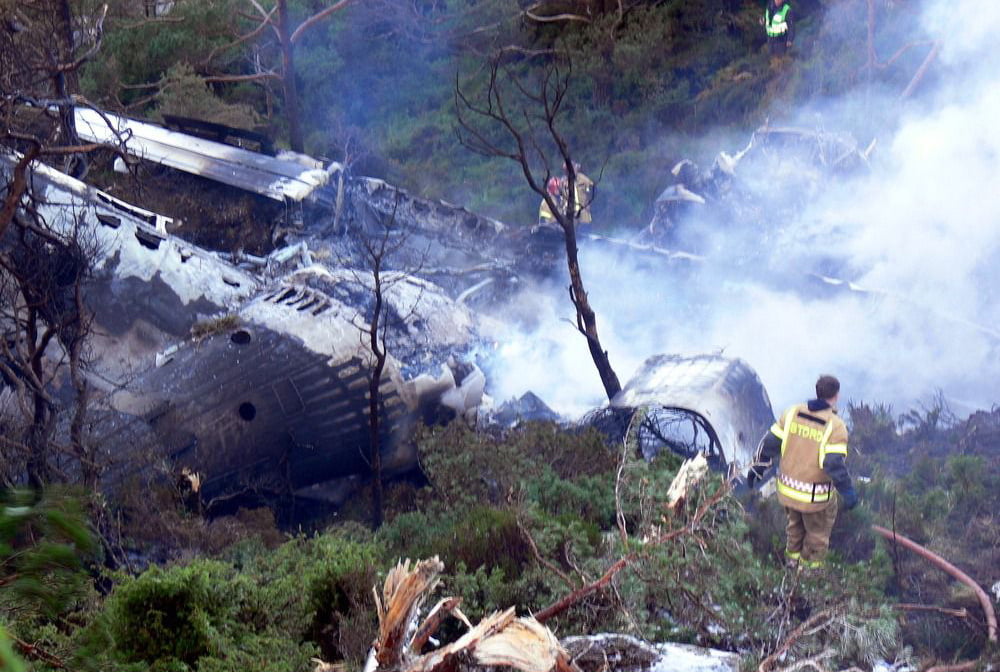Remembering Stord’s 2006 air crash

One of Norway’s worst aviation accidents happened in 2006 on the short runway at Stord Airport in western Norway. Here is the tragic story and the lessons learned.
Atlantic Airways Flight 670 did not stop in time on the short runway at Stord Airport. The British Aerospace 146-200A fell off a cliff and burst into flames, killing four people.
Looking at a photo of the immediate aftermath of the air crash, it’s hard to believe anyone survived one of Norway‘s worst air crashes in recent times. Yet, despite the plane burning, 12 of the 16 people on board survived.
Three Norwegian passengers and a Faroese crew member unfortunately lost their lives. It took five and a half years for the Accident Investigation Board of Norway (AIBN) to publish its final report on the incident. Here is the remarkable story.
About Stord Airport
Even many Norwegians have never heard of Stord Airport. It is a relatively small regional airport serving the island of Stord and the Sunnhordland region of Norway, between Bergen and Haugesund.
It is one of the few airports in Norway with scheduled flights that is not owned and operated by Avinor. However, as several airlines have tried and failed at Stord over the years, the airport receives state support.

At the time of the crash, Stord was well known for its short track. At only 1,460 meters (4,790 ft) long with a landing available distance (LDA) of 1,200 meters, the runway could only accept small aircraft. The track is located 49 meters (160 feet) above sea level, with steep cliffs on three sides.
About the flight
The west coast of Norway is known for its mountainous terrain pierced by the Norwegian fjords, which makes flying the most convenient means of transport.
In 2004, the oil and gas engineering company Aker Kværner began leasing British Aerospace 146-200 aircraft to Atlantic Airways for the travel of its employees to work on the construction of the Ormen Lange gas field near Molde.
On the day of the accident, Flight 670 was scheduled to fly from Stavanger Sola Airport to Molde Airport with an intermediate stop at Stord Airport.

The aircraft’s captain knew Stord well, having made 21 landings as captain on previous occasions. The Captain was the pilot flying the aircraft at the time of the incident.
The Incident
At 7.32 a.m., the plane landed at Stord after a normal approach. The touchdown point was only a few meters from the ideal landing spot.
Just two seconds after touchdown, the pilots realized that the spoilers – which help slow the plane – had not deployed. Braking proceeded normally for a few seconds, then the aircraft stopped slowing.
It was too late to abort the landing and get airborne, so the captain tried to use the brake pedals without effect, then initiated emergency braking. At this point, witnesses observed smoke and spray coming from the landing gear.

In a last ditch attempt to stop a disaster, the captain veered left and right trying to skid the plane to a stop, but it was too late. Just 22.8 seconds after touchdown, the aircraft slid off the end of the runway and rolled down a cliff at a 45 degree angle.
It came to a stop 46 meters (151 ft) from the end of the runway and 50 meters (160 ft) from the sea. Despite the crash, the pilots were able to shut off the fuel supply and activate the fire extinguishers of the motor.
However, the aircraft sustained significant damage and caught fire almost immediately. The pilots were also stuck in the cockpit due to a jammed door, so they had to escape through the left cockpit window.

Unfortunately, the flames spread so quickly that not everyone had time to evacuate the plane. Four people died and six were seriously injured.
The investigation and the conclusions
Representatives of the AIBN arrived on the scene to launch an investigation just hours after the accident. Their investigation was hampered by extensive heat damage to the fuselage and extensive damage to the tape flight data recorder.
They did, however, have access to a film of the immediate aftermath taken by an observer on the other side of the sound, and possibly to the cockpit voice recorder following the restoration work.
From the voice recorder, investigators were able to conclude that the pilots had correctly adjusted the spoiler lever. They were unable to find the underlying cause for the spoiler malfunction, but there were other factors.

When the captain activated the emergency brakes, he deactivated the anti-lock braking system. On a wet track, the brakes locked up and caused a condition known as “reverse rubber aquaplaning”, which basically means that hot tires float on a cushion of vapor, making them much harder to break.
This problem was further compounded due to Stord’s lack of track grooves which carry away surface water and the lack of a safety zone at the end of the track.
During the investigation, the first officer estimated that the speed at that time was only 5-10 km/h (3-6 mph) and that it would have taken only 15 meters (49 feet) of extra runway to stop.
The AIBN concluded that the accident was survivable. Passengers who were able to escape did so through the rear door. Those who lost their lives were near the front of the aircraft and were unable to escape through the blocked/damaged forward exit. Additionally, although fire crews quickly arrived on the scene, they were hampered by the difficult terrain.
Despite identifying training opportunities relating to spoiler-free stopping, the board found that the physical geography of the airport and the lack of adequate safety measures were decisive in the outcome of the accident.